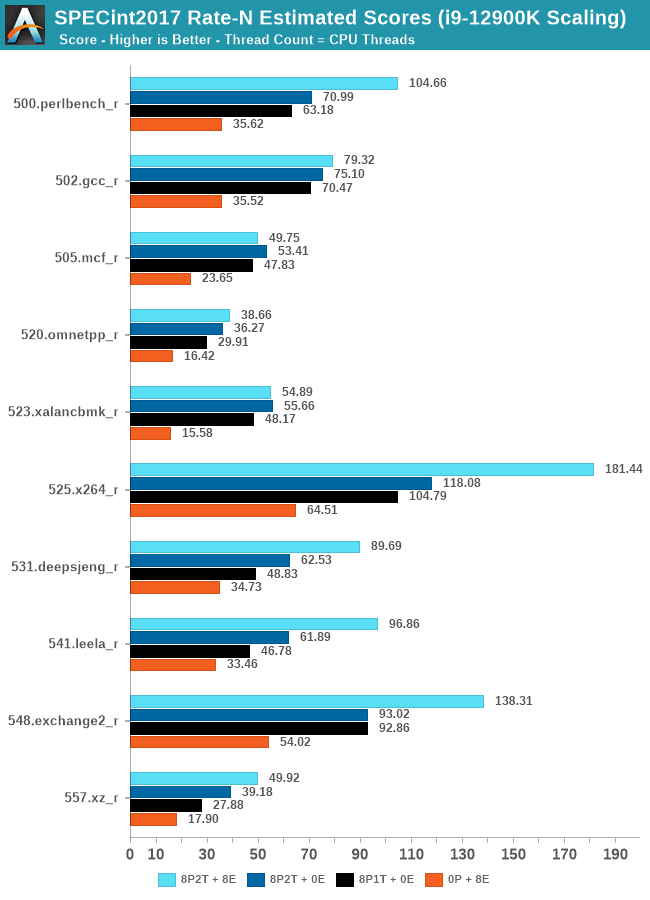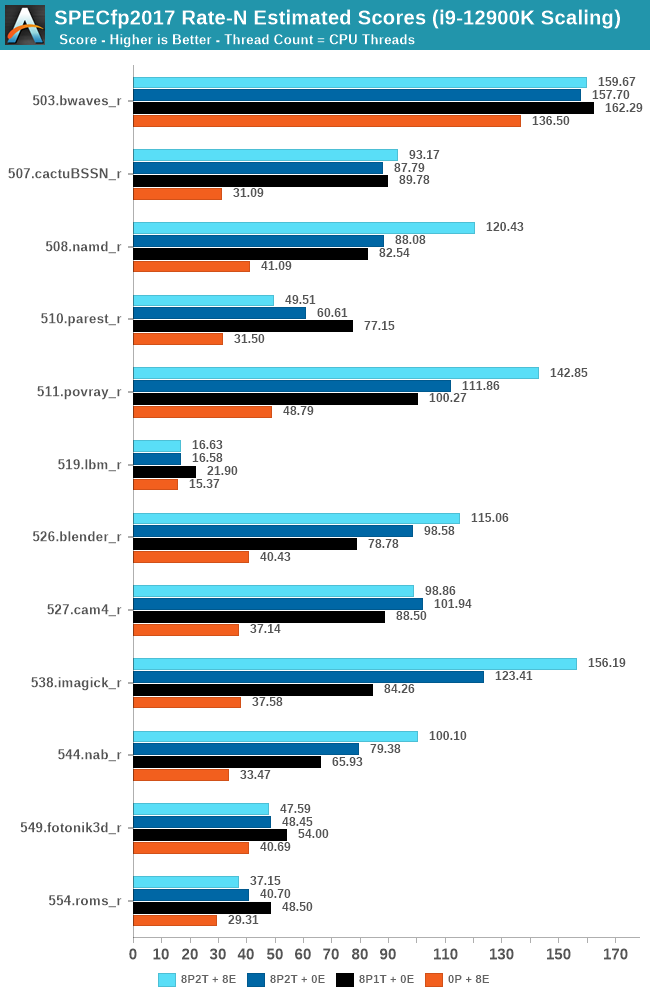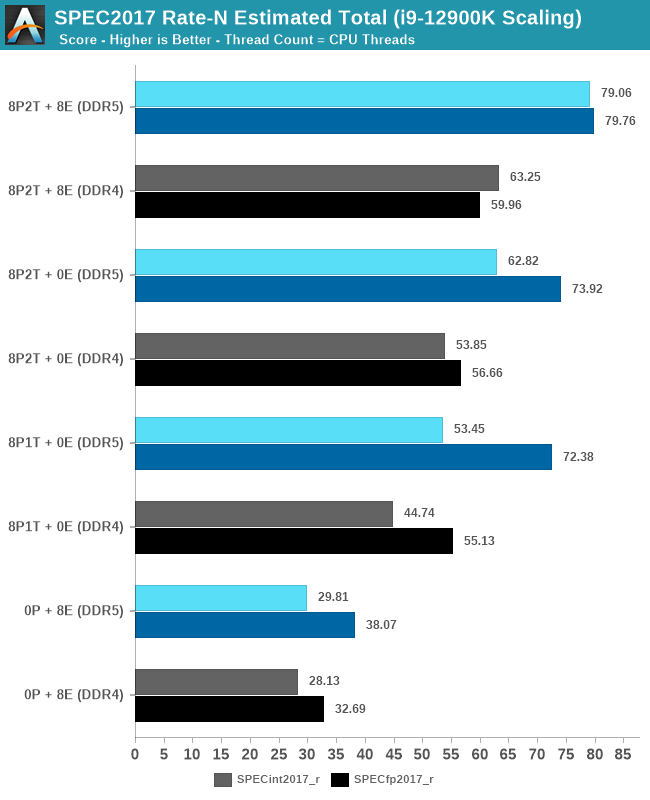The Intel 12th Gen Core i9-12900K Review: Hybrid Performance Brings Hybrid Complexity
by Dr. Ian Cutress & Andrei Frumusanu on November 4, 2021 9:00 AM ESTCPU Tests: SPEC MT Performance - P and E-Core Scaling
Update Nov 6th:
We’ve finished our MT breakdown for the platform, investigating the various combination of cores and memory configurations for Alder Lake and the i9-12900K. We're posting the detailed scores for the DDR5 results, following up the aggregate results for DDR4 as well.
The results here solely cover the i9-12900K and various combinations of MT performance, such as 8 E-cores, 8 P-cores with 1T as well as 2T, and the full 24T 8P2T+8E scenario. The results here were done on Linux due to easier way to set affinities to the various cores, and they’re not completely comparable to the WSL results on the previous page, however should be within small margins of error for most tests.

In the integer suite, the E-cores are quite powerful, reaching scores of around 50% of the 8P2T results, or more.
Many of the more core-bound workloads appear to very much enjoy just having more cores added to the suite, and these are also the workloads that have the largest gains in terms of gaining performance when we add 8 E-cores on top of the 8P2T results.
Workloads that are more cache-heavy, or rely on memory bandwidth, both shared resources on the chip, don’t scale too well at the top-end of things when adding the 8 E-cores. Most surprising to me was the 502.gcc_r result which barely saw any improvement with the added 8 E-cores.
More memory-bound workloads such as 520.omnetpp or 505.mcf are not surprising to see them not scale with the added E-cores – mcf even seeing a performance regression as the added cores mean more memory contention on the L3 and memory controllers.

In the FP suite, the E-cores more clearly showcase a lower % of performance relative to the P-cores, and this makes sense given their design. Only few more compute-bound tests, such as 508.namd, 511.povray, or 538.imagick see larger contributions of the E-cores when they’re added in on top of the P-cores.
The FP suite also has a lot more memory-hungry workload. When it comes to DRAM bandwidth, having either E-cores or P-cores doesn’t matter much for the workload, as it’s the memory which is bottlenecked. Here, the E-cores are able to achieve extremely large performance figures compared to the P-cores. 503.bwaves and 519.lbm for example are pure DRAM bandwidth limited, and using the E-cores in MT scenarios allows for similar performance to the P-cores, however at only 35-40W package power, versus 110-125W for the P-cores result set.
Some of these workloads also see regressions in performance when adding in more cores or threads, as it just means more memory traffic contention on the chip, such as seen in the 8P2T+8E, 8P2T regressions over the 8P1T results.

What’s most interesting here is the scaling of performance and the attribution between the P-cores and the E-cores. Focusing on the DDR5 set, the 8 E-cores are able to provide around 52-55% of the performance of 8 P-cores without SMT, and 47-51% of the P-cores with SMT. At first glance this could be argued that the 8P+8E setup can be somewhat similar to a 12P setup in MT performance, however the combined performance of both clusters only raises the MT scores by respectively 25% in the integer suite, and 5% in the FP suite, as we are hitting near package power limits with just 8P2T, and there’s diminishing returns on performance given the shared L3. What the E-cores do seem to allow the system is to allows to reduce every-day average power usage and increase the efficiency of the socket, as less P-cores need to be active at any one time.










474 Comments
View All Comments
michael2k - Thursday, November 4, 2021 - link
Clock/power scales linearly.It's only Voltage/power that scales geometrically
If you have to increase voltage to increase clock then you can say clock/power is geometric.
So if at a fixed voltage you can go from 2GHz -> 2.5GHz the power usage only goes up by 25%
If you also bump voltage up, however, from 1.2V -> 1.4V, power usage might go up 36%, so that combined you would see a 61% increase in power usage to hit 2.5GHz.
Great_Scott - Thursday, November 4, 2021 - link
Race to Sleep - still a good idea for desktop usage patterns.factual - Thursday, November 4, 2021 - link
Alder is actually more efficient than 5950X in most real world scenarios. PC World did a proper real world power consumption comparison and Alder Lake was superior in most cases. Unless AMD cuts prices dramatically, in makes zero sense to buy Ryzen at this moment ... unless you are a mindless fanboi that is!!meacupla - Thursday, November 4, 2021 - link
I am waiting for AMD to cut prices on their 5600X or 5800X, so I can upgrade from my 2700X.eddman - Thursday, November 4, 2021 - link
Exactly. I'm looking for the same with my 2600.Spunjji - Friday, November 5, 2021 - link
"Unless AMD cuts prices dramatically, in makes zero sense to buy Ryzen at this moment ... unless you are a mindless fanboi that is!!"Or if, you know, you pay attention to how much a whole system costs and make a decision based on that instead of assuming cheap CPU = cheap system?
madseven7 - Saturday, November 6, 2021 - link
Mindless??!! Why?? Cause I can buy a Ryzen 5000 cpu to drop into my current motherboard to replace my Zen+ cpu (2700x). Mindless cause I refuse to pay $750 for 12900k, $450+ for Asus mb not even the best middle of the road, $330 for 32gb of ddr5 and this doesn't even include the aio360 cooler needed. You do the math.Wrs - Saturday, November 6, 2021 - link
What puzzles me is why you haven't already dropped a Zen 3 in that. Zen 3 is basically end of the line for that board. I do not know if "Zen 3+" with vertical cache will even come out, much less be available and affordable for someone who shuns ddr5 costs.AlyxSharkBite - Thursday, November 4, 2021 - link
My argument would be anyone looking at performance per watt on a CPU like this is a bit crazy. I've never considered that important for a CPU you're going to run well out of spec with big cooling anyway.I'm far more interested in perf per watt on the mobile version. That's where it's going to matter as you can't just throw more cooling at a laptop. Especially compared to the Ryzen chips that have extremely good perf per watt.
EnglishMike - Thursday, November 4, 2021 - link
I don't think you have to be crazy, you just have to be one of those few for whom it matters -- i.e. those who execute long-running high-CPU load workloads on a regular basis.Otherwise, yeah, it's mostly irrelevant, given the performance per watt of more typical workloads -- even gaming -- are pretty much inline with the equivalent Ryzen CPUs.